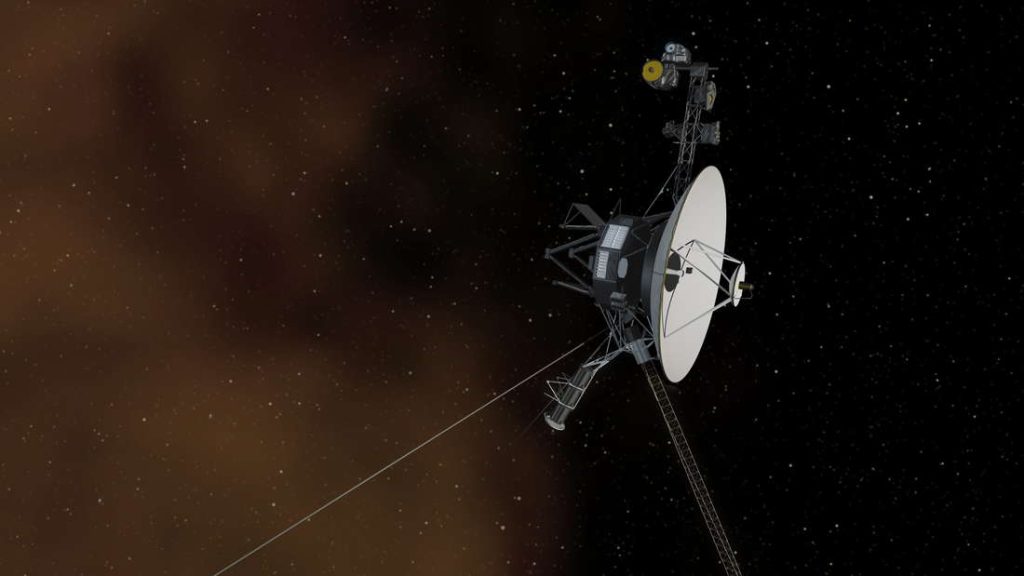The Voyager 1 space probe is a mystery to NASA researchers. What is happening with the legendary probe in interstellar space?
Washington, DC – NASA’s Voyager spacecraft NASA She is legendary. The two probes were launched in quick succession in the summer of 1977 to explore the outer planetary system. Both probes are among NASA’s greatest successes, because they do something incredible: They still regularly send data back to Earth – almost 45 years after they were launched. “Voyager 1” and “Voyager 2” long ago Leave the field of influence of the sun And the Entered interstellar space“Voyager 1” is currently an unimaginable distance of 23.3 billion km from Earth – for comparison: the distance between the Earth and the Sun is about 150 million km.
But recently, the NASA team overseeing the Voyager mission has become concerned about the aging Voyager 1 spacecraft. While working normally, carry out commands from the ground and It collects scientific data and sends it back to Earth, the data from the AACS (Expression and Attitude Control System) instrument does not match what is happening on board. The engineers on the Voyager team are baffled.
NASA’s Voyager 1 space probe: Researchers face a big mystery
The AACS system controls the 45-year-old spacecraft’s orientation in space. This includes, among other things, aligning the high-gain Voyager 1 antenna precisely with the Earth so that the space probe can send data “home”. According to NASA, all indications are that the system is working – “Voyager 1” sends data back to Earth – but the instrument’s telemetry data is clearly wrong. Some of the data would look like it was ‘randomly generated’, some didn’t show the state ‘it could be AACS’. NASA in a statement.
So far, the spacecraft has not sent any error messages, Voyager 1 has not entered safe mode, and the signal it is sending back to Earth has not weakened. This shows that the antenna is still in the correct orientation relative to Earth, NASA explains. “A mystery like this is perfectly normal at this point in the Voyager mission,” says Susan Dodd, Voyager probe project manager at NASA’s Jet Propulsion Laboratory (JPL) in Pasadena. Far beyond what the mission planners expected.”
NASA’s legendary “Voyager” space probes are located in interstellar space
Dodd also suggests that the spacecraft’s environment could also play a role in the current puzzle. “We are in interstellar space — a highly radioactive environment where no spacecraft has flown before. So there are some big challenges for the engineering team.” If the team doesn’t find the cause of this anomaly, they will try to adapt to it, Dodd stresses. “I think if there is a way to solve this problem with AACS, our team will find it.” The error can be fixed through software changes or the use of a redundant hardware system on the spacecraft.
It wouldn’t be the first time the team supporting the Voyager spacecraft had to activate backup hardware. In 2017, Team Voyager 1 began operating the standby engines after the main engines showed signs of deterioration. These motors worked – although they hadn’t been used for 37 years before.
NASA’s Voyager 1 space probe: providing power for scientific instruments
Voyager 1’s twin, the Voyager 2 space probe, is currently located 19.5 billion kilometers from Earth and, according to NASA, is working properly. Meanwhile, many subsystems and heaters on both spacecraft have been shut down to conserve energy for the scientific instruments. And NASA confirmed in a statement so far, that no scientific instruments have been turned off. Team Voyager is trying to keep two spacecraft in operation until 2025.
As the technical staff of the Voyager team attempt to solve the mystery surrounding the Voyager 1 space probe, the team’s researchers deal with scientific data that the two space probes send back to Earth from interstellar space. This requires a lot of patience: it currently takes 20 hours and 33 minutes for the data from Voyager 1 to reach Earth due to the great distance. So when researchers send a command to the spacecraft, it takes roughly two days to get a response from Voyager 1 — but the team is used to working with such large time delays. And it’s worth it: as a bonus, they receive a large amount of data from interstellar space – a region from which data was never transmitted before Voyager. (Tania Banner)
satellite bulletin
Subscribe to free space newsletter And check the latest topics twice a month astronomy And the space travel Tells.

“Total coffee aficionado. Travel buff. Music ninja. Bacon nerd. Beeraholic.”







More Stories
Researchers detect extremely high-energy gamma rays
Anxiety disorders in old age increase the risk of dementia
Researchers are particularly fascinated by these exoplanets.